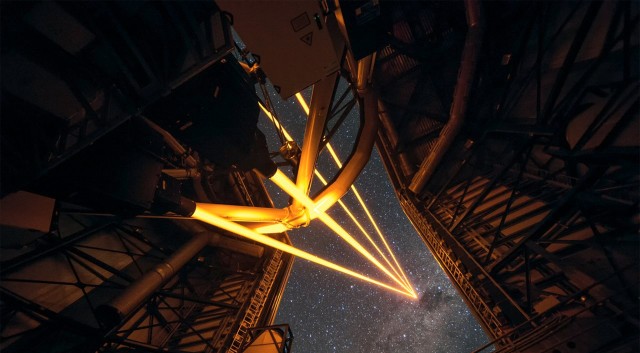With the ESO’s Very Large Telescope, astronomers created a new tool called the Four Laser Guide Star Facility (4LGSF) that is capable of producing the brightest artificial star ever seen.

While astronomers have just about any tool at their disposal these days – telescopes, radio dishes, gravitational wave detectors – that can observe the universe in detail, there is an issue with all that power: you need signals that suffice enough to fulfill all the potential of signal collection.
When you look up at the sky with the naked eye, you won’t be thrown off by the constant motion of the stars. But when you look at the same sky through the lens of a high-powered telescope, the rotation of the Earth may cause your field of view to slide off target every couple of seconds. Having to distinguish between two points that are a fraction of an arcsecond apart can distort your signals and ruin the validity of your observation.
In order to improve their machinery to offset any optical effects in the atmosphere, astronomers turn to guide stars, which are bright, easily identifiable points of light. These let astronomers locate a target area and adjust the telescope to get the best possible reading. However, only a small percentage of the skylines up closely enough to have a guide star for this to work. Without a guide, it’s impossible to deploy a method known as adaptive optics, which allows compensation for small irregularities in the path of light in the atmosphere.
Since nature cannot give astronomers the guide stars they need for observation, they were forced to take it a step further and made those guides themselves. For adaptive optics, they simply need a known, reliable light source coming through the atmosphere in order to see how that atmosphere is affecting light. As a response, astronomers created a laser guide star, which is an artificial light source in the upper atmosphere that provides the needed reference light beams.
The 4LGSF facility uses lasers to excite the atoms in the upper atmosphere, causing them to emit light. The Very Large Telescope uses four 22-Watt lasers to excite sodium atoms, emitting a specific glow much brighter than any other manmade point in the sky. The light from this artificial star filters down through the telescope, similarly to how light from a real one would.
With this synthetic guide, astronomers can use a wider array of stars than ever before, including those that are faint. And by opening the guide book to dimmer stars, it increases the number of adaptive optics that can be used.
Via ExtremeTech
Advertisement
Learn more about Electronic Products Magazine





